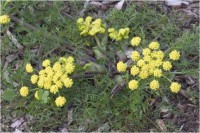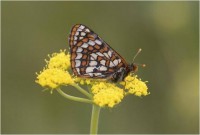SPP Plant Profile: Spring Gold (Lomatium utriculatum)
By Graduate Research Associate Evan Hayduk
Basic Information:
Lomatium utriculatum, or Spring Gold, grows in upright clumps with mostly basal leaves. Leaf blades are dissected into very narrow, fern-like ornate leaves. Flowers are small and bright yellow, and clustered in open umbels. Spring gold grows in meadows, woodlands, open and rocky areas from California to British Columbia. A spring flowering perennial, it has a persistently blooming flower, often flowering from as early as January to late July.
Ecological Importance:
Lomatium utriculatum has been found to be the primary nectar sources of Taylor’s checkerspot (Euphydryas editha taylori) butterflies in certain locations. Where it is not present, Taylor’s checkerspots use wild strawberry (Fragaria spp.) instead. In restoration efforts, planting of important nectar source species, like Spring Gold, near larval host plants such as Harsh Indian Paintbrush (Castilleja hispida) is important because Taylor’s checkerspot butterflies do not move a long distance when foraging or laying eggs.
At the Scatter Creek Wildlife Area, in south Thurston County, Lomatium utriculatum has also been found to be an important nectar species for mardon skipper (Polites mardon) butterflies.
Fun Facts:
Lomatium is in the carrot family, and the root is edible raw or cooked. It can also be dried and ground into a power or roasted as a vegetable. Young leaves and shoots can also be eaten raw or cooked as greens. Historically, a decoction of the plant was used as a wash for swollen or broken limbs. The root of the plant is analgesic and stomachic; it was chewed or infused as a treatment for headaches and stomach upset.
- Lomatium utriculatum can bloom from January to July.
- Taylors checkerspot butterflies use Spring Gold as a primary nectar source.

